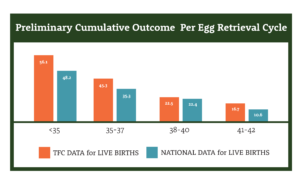The latest IVF success rates report: How to read it and why we are thrilled

In 1985, just five years after our Austin fertility center was founded, the Society for Assisted Reproductive Technology (SART) began keeping track of IVF cycle outcomes. The annual report gives us a snapshot of the national average pregnancy rates. The IVF success rate report also breaks down the rates by age and fertility center.
IVF has changed dramatically in the past five years with improvements to egg freezing, genetic testing and the way we care for embryos in the lab. We can now confidently transfer one embryo at a time (elective single embryo transfer – eSET) in most patients, knowing that this is best for both mothers and babies.
The way SART reports the data has changed, too!
While the report is certainly more complicated and much more difficult to interpret, these changes were designed to make sure that every center reports data in the same way. In the past few years, some centers took advantage of the rules – making their pregnancy rates look substantially better than those from programs that followed the rules. While it will take some time for patients (and doctors!) to adjust to the new report, the hope is that – over time – the new reporting format will give patients a better idea of their true chance for pregnancy at each U.S. center.
Announcing the newest IVF success rates
In 2015, there were 67,818 babies born from 213,004 IVF cycles as reported by 371 SART member clinics.
We are especially excited about the fact that more programs are doing what we have been doing for several years now – transferring only one embryo at a time in the majority of our patients. In 2015, more than a third (34.5 percent) of all IVF cycles performed in the US had elective single embryo transfer, up from 27.2 percent in 2014. Over 80 percent of parents who successfully conceived with IVF in 2015 with TFC took home their one, perfect baby, rather than twins or triplets.
“At TFC, we accomplished our goal of surpassing the national average in all age categories, and did so while transferring only one embryo at a time in the vast majority of our younger patients,” said Medical Director Kaylen Silverberg, M.D. “We are so proud of the fact that we have been able to achieve such high pregnancy rates while eliminating triplets and markedly reducing our number of twins.”
How to read a IVF success rate report
We encourage you to watch the video that explains explains how to read the SART clinic report. When reviewing the SART report, you should not just look at pregnancy rates. There is a lot of information you should consider when selecting a center to perform your IVF treatment. In addition to pregnancy rates, you should closely look at these factors:
- The percent of cycles with a single embryo transfer (eSET)
- The average number of embryos transferred
- The percentage of multiple pregnancies reported
- The average patient age
- The number of cycles performed at each center
- The number of donor egg cycles
Some centers achieve good pregnancy rates because they transfer several embryos – leading to a higher rate of multiple pregnancy. Other programs do a lot of donor egg cycles – either because they have an older patient population or because they don’t want to treat poor responders with their own eggs, as that would lower the pregnancy rate the center would have to report to SART. At our fertility center, we love challenging cases, and believe that all men and women deserve the chance to become parents.
If you would like more information about the 2015 SART IVF success rates and how our Austin fertility clinic stacks up, please contact us here.














Comments are closed.